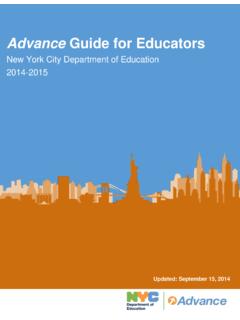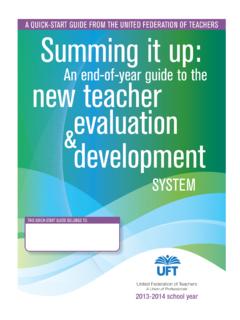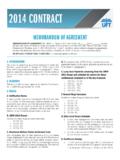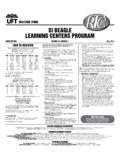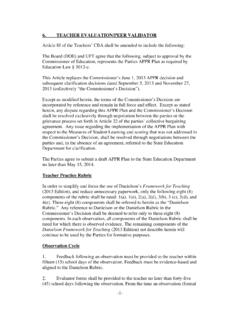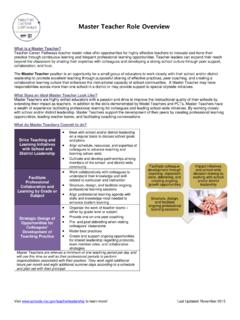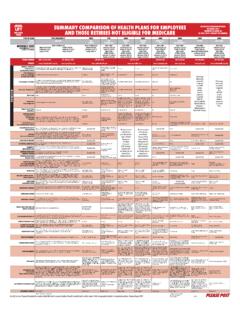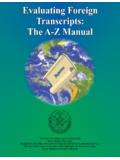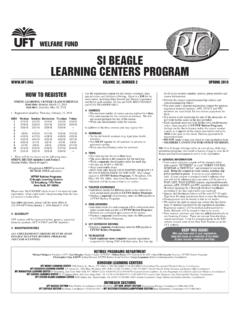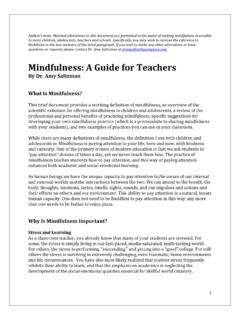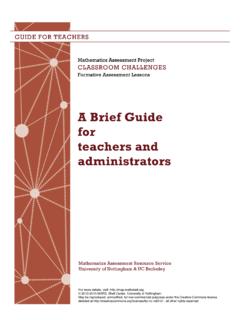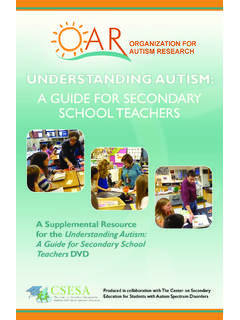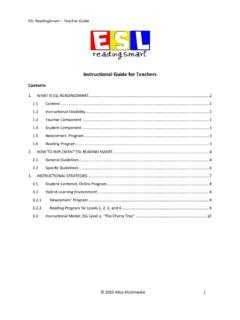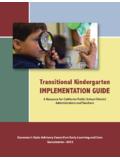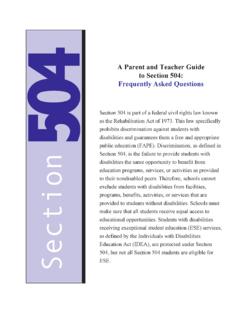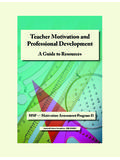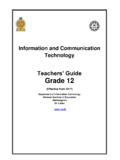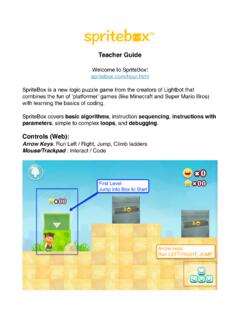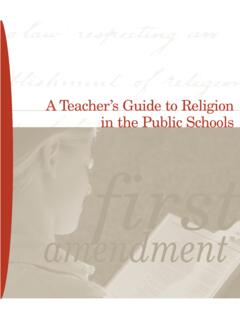Transcription of YOUR GUIDE TO THE TEACHER EVALUATION …
1 YOUR GUIDE TO THE TEACHER EVALUATION SYSTE MDECEMBER 20161 AN OVERVIEW DECEMBER 2016 FOR YOUR REFERENCE: DOCUMENTS YOU SHOULD KEEPMany of your records, including observation reports and details about your Measures of Student Learning, can be found on your Advance Web Application page at Be sure to print or electronically save these pages as they may become unavailable after the end of the school year. Teachers should ensure data in all applicable systems (Web App, STARS, Schoolnet) are OF TEACHER PRACTICE (MOTP) OBSERVATION OPTION SELECTION FORM: Your selection of an observation option should have been submitted to the school in writing on this form during the fall. You should have kept a signed copy. Teachers who selected observation Option 1 should have indicated on this form whether they wanted to use the initial planning conference (IPC) as their pre-observation conference.
2 This form also records your consent, if you choose to give it, to allowing your observation to be videotaped. This consent requires both your and your evaluator s FORM: Your evaluator must provide you with a copy of this form within 45 school days of the observation. Keep a copy of this LISTS/ROSTERS: Keep a copy of the names of students in your classes at the beginning of the year. Update the list as the students in your classes change and make note of the dates of changes. Be sure to participate this spring in roster maintenance and verification to make sure the right students are part of your FOR ASSISTANCE: Keep records of your requests to your evaluator for professional development, materials or other forms of assistance and the response to those : If you are concerned you will receive an Ineffective rating due to harassment or based on something other than job performance, keep an objective log of events that can support your claim if you have to appeal a rating.
3 If you receive an Ineffective rating, notify your UFT chapter leader or UFT district representative and provide him or her with your CONCERNS?If you are concerned about possible procedural violations in your Annual Professional Performance Review, ask your chapter leader about the APPR resolution assistance process and the form. (Read about procedural violations on the UFT website at ) You have five school days from knowledge of the act or occurrence to file the appropriate paperwork. Contact your chapter leader or district representative with questions or concerns. Your district representative can be reached at the union s borough offices:Bronx: 718-379-6200 Mon. - Fri.: 10 - 7 Brooklyn: 718-852-4900 Mon. Tues.: 10 6:30 , Wed. Fri., 10 6 Manhattan: 212-598-6800 Mon. - Thurs.: 10 - 7 , Fri.
4 : 10 - 6 Queens: 718-275-4400 Mon., Tues., Wed., Fri.: 10 - 6 , Thurs.: 10 - 7 Staten Island: 718-605-1400 Mon., Wed., Thurs., Fri.: 10 - 6 , Tues.: 10 - 7 OVERVIEW DECEMBER 2016 2AN OVERVIEW OF THE NEW EVALUATION SYSTEMDear Colleagues,We ve put together this GUIDE to introduce you to important improvements we ve negotiated with the Department of Education for your EVALUATION this year and to changes to your EVALUATION in worked with the DOE to revise the TEACHER EVALUATION system so it not only aligns with the new state law, but it s fairer and reduces the impact of standardized tests. We re proud that we re creating more authentic student learning measures, from essays and projects to demonstrations of proficiency in physical education and the arts, which genuinely establish what we teach in our classrooms and what our students are ve maintained the advantages of a multiple-measures system , but we are moving from two learning measures to one.
5 The student learning assessment will carry less weight and your strengths as a TEACHER will be valued. This also means a reduced emphasis on tests in your classroom and a renewed emphasis on the work your students do every day and over the course of the school year. That s what really ve also improved the options teachers have when it comes to observations giving you more flexibility. The observation system we ve developed provides a collaborative approach to evaluating a TEACHER s strengths and gives our members the opportunity to demonstrate their professionalism and passion for their , but not least, I m happy to tell you that we ve maintained the voice teachers have when it comes to selecting student learning measures that work for them in their individual schools.
6 The school-based Measures of Student Learning committees remain a strong fixture in the deserve a professional EVALUATION system in which administrators and teachers can work together to improve instruction in a safe and respectful environment. Those are the beliefs that underpin this agreement. Sincerely, Michael Mulgrew UFT PresidentIn this GUIDE , we ve included A list of professional records you should keep What you need to know for the remainder of this school year, January through June 2017 A look ahead at the changes for the 2017-18 school year Definitions of commonly used terms in this guide3 AN OVERVIEW DECEMBER 2016 WHAT YOU NEED TO KNOW FOR 2016-17 What is the same this year?This EVALUATION system covers most K-12 teachers. It covers classroom teachers who work for at least six months of the year and spend at least 40 percent of their time as the TEACHER of record for example, 10 of 25 teaching periods per week for middle school and high school teachers.
7 The new EVALUATION system is not for TASC and adult education teachers, guidance counselors, hearing education and vision education teachers who do not teach classes, school librarians who are not teachers of record, occupational and physical therapists, paraprofessionals, pre-kindergarten and LYFE (Living for the Young Family through Education) teachers, school nurses, school psychologists, school secretaries, social workers, speech teachers who only provide related services, substitute teachers and TEACHER Initial Planning Conference should have been held on or before Oct. 28, 2016. You had four options for observations. All formal and informal observations must be completed after the IPC and no later than June 2, the first Friday in June. You must receive feedback in 15 school days and a written observation report in 45 school days.
8 Components can be rated only when there is observable evidence. All observable evidence must be summative end-of-the-year conference must be held between the last Friday in April (April 28, 2017) and the Friday (June 23, 2017) before the last day of school. By the school year s last day, the evaluator must provide, in writing, the TEACHER s rating for the observation subcomponent. Follow-ing the end-of-the-year conference and by Sept. 1 of the following school year, the TEACHER must receive a full rating including both Measures of TEACHER Practice and Measures of Student Learning. Every school must have a school-based Measures of Student Learning (MOSL) committee. The committee comprises eight members, four selected by the UFT chapter leader and four selected by the school principal. School committees select student learning measures for their options for this school year, 2016-17, remain the 1: A minimum of one formal classroom observation and three informal 2: A minimum of six informal classroom 3: For teachers rated Highly Effective the prior year.
9 A minimum of three informal observations. The TEACHER makes his or her classroom available for three non-evaluative visits from a colleague Option 4: Available to teachers rated Effective the prior year. A minimum of four informal TEACHER Improvement Plan process remains the same. A TEACHER who receives a rating of Developing or Ineffective must develop a TEACHER Improvement Plan with the school principal. This is a collaborative process with the administration. The purpose is to assist teachers to work to their fullest potential. The plan identifies specific improvement areas as well as a timeline and plan for assessing improvement. The TIP is in no way part of the year-long TIP, the TEACHER and evaluator hold three meetings, the first one in the fall. The second meeting must be held between Jan. 2 and April 30.
10 The third meeting is the summative end-of-the-year conference, which must be held between the last Friday in April and the last Friday in OVERVIEW DECEMBER 2016 4 WHAT YOU NEED TO KNOW FOR 2016-17 What is different this year?Starting this year, you will have one student learning measure instead of two. It will be combined into a final rating in a simpler, fairer way. Your school-based Measures of Student Learning committee will make the decision about what measure works best for the school for any grade and subject that is not mandated by state law, unless your principal and the committee do not agree. In that case, a systemwide default measure selected by the schools chancellor will be assessment your school chooses, it will not carry the same high stakes it carried in the past. This is because of the new method for creating final ratings, which relies on a matrix instead of a score.
